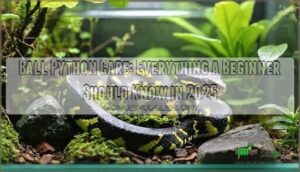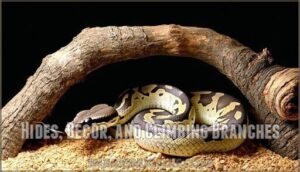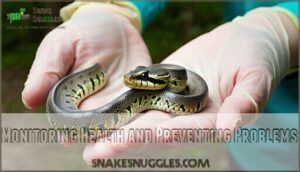This site is supported by our readers. We may earn a commission, at no cost to you, if you purchase through links.
 You’ll find that ball python care everything a beginner should know starts with understanding these docile African natives make perfect starter snakes. They’re nocturnal creatures who curl into defensive balls when stressed, hence their name. These gentle giants can live over 30 years with consistent care, making them rewarding long-term companions.
You’ll find that ball python care everything a beginner should know starts with understanding these docile African natives make perfect starter snakes. They’re nocturnal creatures who curl into defensive balls when stressed, hence their name. These gentle giants can live over 30 years with consistent care, making them rewarding long-term companions.
Your ball python needs a 40+ gallon enclosure with proper heating (88-92°F basking spot), 50-60% humidity, and secure hiding spots. The secret lies in mastering their thermal gradients and recognizing subtle behavioral cues that signal contentment.
Feed juveniles weekly and adults every 1-2 weeks with appropriately-sized frozen-thawed rodents. Monitor for respiratory infections (wheezing sounds) and shedding problems, scheduling annual vet checkups with exotic specialists.
Table Of Contents
- Key Takeaways
- Ball Python Basics for Beginners
- Setting Up The Perfect Enclosure
- Managing Temperature, Lighting, and Humidity
- Feeding, Handling, and Routine Care
- Monitoring Health and Preventing Problems
- Frequently Asked Questions (FAQs)
- How to take care of a ball python for beginners?
- What to know before getting a ball python?
- How to handle a ball python for the first time?
- What all do I need for a ball python?
- How often should the enclosure be deep cleaned?
- Is it safe to house two ball pythons together?
- Do ball pythons recognize and bond with their owners?
- At what age can ball pythons start breeding?
- Are there any special considerations for feeding during brumation?
- Can ball pythons live together in one enclosure?
- Conclusion
Key Takeaways
- Set up proper habitat conditions – You’ll need a 40+ gallon tank with a temperature gradient (88-92°F basking spot, 72-80°F cool side) and maintain 50-60% humidity with secure hiding spots on both ends.
- Establish consistent feeding routines – Feed juveniles weekly and adults every 1-2 weeks with appropriately-sized frozen-thawed rodents that match your snake’s midsection width (10-15% of body weight).
- Monitor health through regular observation – Watch for respiratory infection signs like wheezing, shedding problems from low humidity, and behavioral changes that indicate stress or illness requiring veterinary care.
- Understand you’re making a long-term commitment – Ball pythons live 15-30 years and require consistent care, making them rewarding companions when you’re prepared for decades of responsibility.
Ball Python Basics for Beginners
You’re about to enter the fascinating world of ball pythons, one of the most beginner-friendly snake species that can live over 30 years with proper care.
These docile, 4-5 foot African natives earned their name by curling into a protective ball when stressed, making them relatively easy to handle once you understand their basic needs for temperature, humidity, and feeding schedules.
Natural Habitat and Behavior
Ball pythons call African habitats home, from grasslands to forests. These nocturnal creatures spend days hiding in burrows, emerging at night to hunt. Understanding their burrowing behavior helps you create proper habitat conditions.
They’re solitary snakes with minimal social interactions, preferring individual territory. Their wild diet consists mainly of small mammals and birds found near agricultural areas.
Lifespan and Size
When you’re planning for Ball Python Care, understanding their impressive growth journey helps set realistic expectations. Your snake will reach adult size around three years, with males usually measuring 3.6-4.3 feet and females slightly larger at 3.8-4.5 feet due to sexual dimorphism. With proper health management, you’ll enjoy a 15-30 year lifespan together—quite the commitment!
- Maximum size varies between captive and wild populations
- Growth rate slows dramatically after reaching maturity
- Captive longevity often exceeds wild counterparts substantially
- Morph influence on size remains minimal across varieties
Common Morphs and Genetics
You’ll encounter different morphs showcasing Ball Python genetics through captive breeding programs. Morph identification helps you understand genetic inheritance patterns. Designer morphs combine multiple traits, while recessive genes require both parents carrying specific alleles. Dominant traits appear with just one copy. Many keepers enjoy exploring the vast array of ball python morphs.
| Morph Type | Inheritance | Price Range |
|---|---|---|
| Albino | Recessive Genes | $200 |
| Banana | Incomplete Dominant | $300 |
| Piebald | Recessive | $400+ |
| Spider | Dominant Traits | $150 |
Snake genetics determine your pet’s appearance and potential health considerations in Ball Python care.
Setting Up The Perfect Enclosure
You’ll create your ball python’s home base by selecting the right tank size, substrate, and hiding spots that match their natural African habitat.
Getting these foundational elements right from the start prevents stress-related health issues and sets you up for decades of successful snake keeping.
Choosing The Right Tank Size
Your ball python habitat size directly impacts their health and behavior. Hatchlings need 10-gallon tanks (20″ x 11″ x 13″), while adults require 40+ gallons minimum.
Enclosure dimensions should be 36″ x 18″ x 12″ for grown snakes. Don’t skimp on vertical space – ball pythons climb more than you’d think.
Plan for future growth when buying your first tank.
Best Substrate Options
Choosing the right substrate sets the foundation for your Ball Python’s health and comfort. Coconut husk and cypress mulch excel at Humidity Retention while providing natural Ball Python Habitat conditions. These Substrate Mixtures support proper shedding and Odor Control.
Paper towels work for quarantine but lack enrichment. Avoid sand and cedar—Substrate Safety matters most. Cost Comparison favors coconut fiber long-term.
A clean substrate helps maintain a healthy living space for your ball python. Adding moss to hides boosts humidity without creating soggy conditions.
Hides, Decor, and Climbing Branches
Your ball python needs secure hiding areas to feel safe in its Ball Python Habitat. Provide at least two hides—one on each temperature zone—with snug entrances for proper Enrichment Importance.
- Hide Variety: Use commercial caves or DIY options like plastic containers with entrance holes
- Climbing Safety: Add sturdy branches for semi-arboreal behavior, ensuring they won’t collapse
- Decor Hygiene: Choose non-porous materials that clean easily and complement your substrate
Remember Naturalistic Design principles while prioritizing safety over aesthetics.
Managing Temperature, Lighting, and Humidity
You’ll need to master three critical environmental factors to keep your ball python healthy: temperature, humidity, and lighting.
Getting these wrong can lead to serious health problems like respiratory infections, poor shedding, or digestive issues that’ll have you rushing to the vet.
Creating a Thermal Gradient
Temperature monitoring tools help you establish the perfect thermal gradient across your Ball Python habitat. Set your basking spot at 88-90°F on one side, dropping to 72-80°F on the cool side. This gradient size impact allows your snake to thermoregulate naturally, moving between zones as needed.
Heat source placement matters—position it under one-third of the enclosure. Monitor both substrate surface and ambient temperatures regularly, making seasonal adjustments as needed for ideal Ball Python behavior.
Selecting Heating Sources and Lamps
Getting your heating setup right makes all the difference for your ball python’s health. Thermostat importance can’t be overstated—they prevent dangerous overheating that could harm your pet.
Here are five essential heating options to examine:
- Halogen bulbs – Best basking spot setup, mimicking natural sunlight
- Deep heat projectors – Outstanding nighttime heat sources without light
- Under-tank heaters – Heat mat safety requires thermostats always
- Ceramic heat emitters – Reliable nighttime warmth for larger tanks
- UVB lamps – Support natural behaviors and vitamin D3 synthesis
When comparing bulb types, choose white halogen over colored options for better visibility. Install guards around all heat sources to prevent burns during your ball python’s nighttime explorations.
Maintaining Proper Humidity Levels
You’ll want to keep humidity between 50-60% for routine Ball Python care, bumping it up to 70% during shedding cycles. Use a reliable hygrometer for humidity monitoring – your snake’s respiratory health depends on it.
Too low causes Ball Python shedding problems, while excess moisture invites mold. A large water bowl helps maintain proper hydration importance in your pet’s habitat naturally.
Feeding, Handling, and Routine Care
You’ll need to establish proper feeding schedules, learn safe handling techniques, and maintain a clean environment to keep your ball python healthy and stress-free.
These daily care routines form the foundation of successful snake ownership, and getting them right from the start prevents most common health problems you’ll encounter.
Feeding Schedule and Prey Size
Your ball python’s feeding schedule depends on age and size. Hatchlings need frozen rodents every 5-7 days, while adults eat every 14-21 days.
Choose prey matching your snake’s midsection width—usually 10-15% of body weight. Use feeding tongs and proper thawing methods for safety.
Monitor for feeding refusal reasons like stress or temperature issues.
Safe Handling Techniques
Proper handling keeps both you and your ball python safe during routine pet care interactions. Watch for stress signals like defensive coiling or hissing before approaching your snake.
- Support the body with a secure grip using both hands
- Move slowly to avoid triggering defensive responses
- Limit handling frequency to 2-3 times weekly maximum
- Supervise children closely during any handling sessions
Never handle during feeding time or shedding periods when bite prevention becomes critical.
Cleaning and Maintenance Tips
Clean your ball python’s habitat weekly to prevent bacterial growth and odor control. Spot-clean soiled substrate immediately, then perform full substrate cleaning and enclosure disinfection monthly.
Replace water every week, checking for mold prevention around humid areas. During cleaning, maintain proper humidity levels and guarantee substrate stays appropriately dry to avoid scale rot.
Monitoring Health and Preventing Problems
You’ll want to spot health problems early, since ball pythons can hide illness until conditions become serious. Regular observation of your snake’s behavior, eating habits, and physical appearance helps catch issues like respiratory infections, scale rot, or shedding problems before they require emergency veterinary care.
Ball pythons often hide illness until conditions become serious, making early detection through regular observation of behavior, eating habits, and physical appearance crucial for preventing emergency veterinary situations
Recognizing Signs of Illness
Like spotting storm clouds before the rain, recognizing early illness signs in your Ball Python can prevent serious health problems. Respiratory infections cause wheezing sounds, while scale rot creates foul odors and discolored scales. Parasite detection requires watching for weight loss and abnormal stools. Anorexia and lethargy signs often indicate underlying issues requiring immediate veterinary care.
- Audible wheezing or clicking sounds during breathing
- Foul-smelling discharge around mouth or nostrils
- Visible blisters or reddish, swollen scales on belly
- Sudden refusal to eat lasting over a month
Shedding and Skin Care
During shedding cycles, ball pythons need extra humidity to prevent stuck shed problems. You’ll notice their skin becoming milky and eyes turning blue before they shed. Increase humidity to 70% using damp moss in their hide.
Shedding frequency varies—juveniles shed monthly, while adults shed several times yearly. Poor humidity causes stuck shed, which can lead to scale rot and serious skin health issues. Monitor your snake’s shedding pattern closely.
Veterinary Care and Preventive Checks
Beyond basic care, your Ball Python needs professional veterinary support for long-term health. Annual check-ups catch problems early, while parasite prevention keeps common ailments at bay.
- Schedule yearly exams with exotic veterinarians for thorough health assessments
- Request fecal testing during visits to screen for internal parasites
- Learn signs of a healthy ball python: clear eyes, clean vent, relaxed behavior
- Establish quarantine protocols for new snakes to prevent disease transmission
- Keep emergency care contacts readily available for urgent health situations
Frequently Asked Questions (FAQs)
How to take care of a ball python for beginners?
Before smartphones existed, snake keeping required old-school dedication. You’ll need proper heating (88-90°F basking spot), humidity at 50-60%, secure hiding spots, and weekly frozen-thawed rodent meals for juveniles.
What to know before getting a ball python?
You’ll need a 30+ year commitment, proper enclosure setup with temperature gradients, and budget for veterinary care. Ball pythons require specific humidity levels, frozen-thawed rodents, and minimal handling during shedding periods.
How to handle a ball python for the first time?
Like approaching a sleeping giant, you’ll want to move slowly and confidently. Wash your hands first, then gently support the snake’s body with both hands while avoiding sudden movements that might startle them.
What all do I need for a ball python?
You’ll need a 40+ gallon tank, heat source with thermostat, humidity gauge, secure hides, water bowl, appropriate substrate, and frozen-thawed rodents for feeding.
How often should the enclosure be deep cleaned?
You should deep clean your ball python’s enclosure weekly with full disinfection. Spot clean waste immediately when noticed.
During shedding periods, you might need more frequent cleaning to maintain proper hygiene.
Is it safe to house two ball pythons together?
You shouldn’t house two ball pythons together. They’re solitary creatures that stress easily when cohoused, leading to feeding problems, aggression, and disease transmission risks.
Do ball pythons recognize and bond with their owners?
Think medieval tapestry depicting serpent recognition—ball pythons don’t form emotional bonds like dogs.
They recognize your scent, heat signature, and handling patterns through basic conditioning. You’re simply their reliable food source and safe transport, not their beloved companion.
At what age can ball pythons start breeding?
Males can breed around 16-18 months when they’re 700 grams or heavier. Females need to wait longer — about 27-31 months and weigh at least 1,200 grams.
Weight matters more than age for breeding readiness.
Are there any special considerations for feeding during brumation?
Ball pythons can fast for 2-6 months during brumation naturally. During this dormant period, you’ll want to completely stop feeding your python since their slowed metabolism can’t properly digest food, potentially causing dangerous health complications or death.
Can ball pythons live together in one enclosure?
No, you shouldn’t house ball pythons together. They’re naturally solitary creatures who get stressed when sharing space. Co-housing increases disease transmission, feeding competition, and territorial aggression risks.
Conclusion
Think of successful ball python ownership as tending a garden—patience, consistency, and attention to detail yield rewarding results. You’ve now learned that ball python care everything a beginner should know revolves around mastering environmental conditions, feeding schedules, and health monitoring.
Your snake’s well-being depends on maintaining proper temperatures, humidity levels, and recognizing early warning signs of illness. With dedication and these fundamentals, you’re equipped to provide excellent care for your scaly companion throughout their decades-long lifespan.
- https://reptifiles.com/ball-python-care-guide/ball-python-terrarium-size-lighting/
- https://www.wilbanksreptiles.com/blogs/ball-pythons/common-ball-python-health-issues-and-how-to-prevent-them
- https://www.youtube.com/watch?v=rNpljc5aH1k
- https://www.reddit.com/r/ballpython/comments/rlglbg/tips_for_ball_python_care/
- https://community.morphmarket.com/t/beginners-guide-to-ball-python-care/46925














